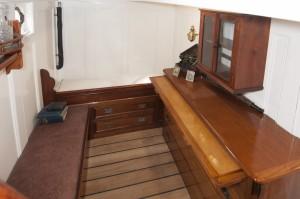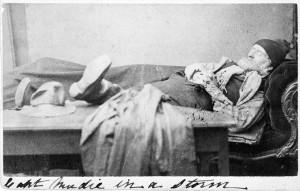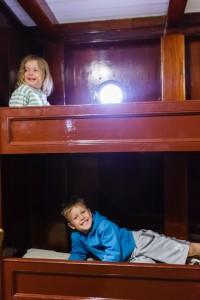Essential Information
| Location |
Cutty Sark
|
|---|---|
01 Oct 2015
When the ship was built in 1869, some of the crew slept in accommodation in the fo’c’s’le below the Main Deck. In this space, there were originally 10 bunks for the Ordinary and Able Seamen and although the bunks are no longer there, the portholes are in situ and it is still possible to see the stamp in the beam certifying the number of men who could be berthed there. After the ship’s second voyage, however, this space was abandoned because it was too uncomfortable being right at the front of the ship, and it was difficult to get the men up on deck quickly. A new deckhouse was built on the Main Deck and in 1872, the petty officers and apprentices moved into the new, aft deckhouse and the Ordinary Seamen and Able Seamen then slept in the forward deckhouse. The fo’c’s’le was then probably used partly as a store and partly as an additional cargo space.

The Master and two Mates had their accommodation at the stern of the ship, known as the Liverpool House. As might be expected, these cabins were relatively more luxurious and each officer had a separate cabin. The original specification for Cutty Sark details that these cabins were also “fitted up with drawers, chronometer case, chart racks, etc.”

Cutty Sark’s crew however did not get much time to spend in their cabins or sleep on board. Their day was dominated by the watch system which meant they had 4 hours at work then 4 hours off duty when they might be able to catch some sleep. Any sleep might be interrupted by stormy weather when all hands would be required on deck and the crew off watch were roused from their beds. Clarence Ray, apprentice on board 1894-5 writes in a letter to his mother “after a hard day’s work I slept like a top, you bet, but was fetched out of it in the middle to drop anchor in the Downs when the tug Shamrock left us”. He later reports “If we go to sleep in our watch on deck they make us ride the grey mare - that is sit up on the upper topsail yard for the rest of the watch. I have not had to do this yet but the other fellow has, twice.” Later in the ship’s career when Cutty Sark had been sold to a Portuguese company and re-named Ferreira, the arrangement of the captain’s accommodation was relocated within the Liverpool House. A report on board in May 1913 states that the captain’s cabin was “was stripped of most of its old fittings, only a marble-topped washstand and a heavy, teak four-post bed remaining”.

Today, the crew accommodation on board Cutty Sark is arranged as she would have appeared in 1872 and visitors are welcome to put themselves into the shoes of the crew and try out a bunk for size.